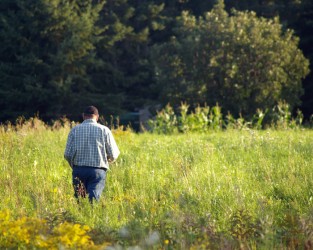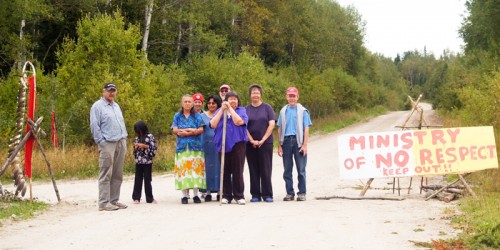Article Origin
Volume
Issue
Year
Andrew (Shoon) Keewatin, Jr. admits he wasn’t surprised when his nine-year court battle against logging on Grassy Narrows First Nation’s traditional territories was defeated July 11 in the Supreme Court of Canada.
“It was the kind of decision I was expecting,” the trapper and hunter tells Windspeaker, his home full of furs harvested from his extensive traplines. But taking the Ontario government to court over its approval of forestry permits was a necessary tactic in his community’s long struggle for justice.
“I noticed there was a lot of clear-cutting on my trapline, and pretty soon it was coming right down to the river,” recalls Keewatin as he reflects on launching his legal challenge in 2005.
“My biggest fear is that I won’t be able to trap — but that is happening already. They’ve clearcut a lot of areas.”
From Asubpeeschoseewagong (Grassy Narrows) First Nation — a remote Anishinabe community that is home of the longest blockade in Canada’s history — Keewatin took Ontario’s Ministry of Natural Resources to task after it issued a forest license to logging firm Abitibi-Consolidated.
Now, despite its legal defeat, Grassy Narrows is vowing to continue defending its Treaty No. 3 territories in northern Ontario, pointing out that the court did not, however, allow for unimpeded clear-cutting of the area, since Ontario must exercise its logging rights within the requirements of the treaty, which includes timber harvesting rights and traditional uses to Indigenous peoples as well.
The decision came only weeks after the same court granted a landmark victory to a B.C. First Nation which was also fighting a provincial logging approval on their traditional lands, with one key difference: Tsilhqot’in nation never signed a historic treaty and is therefore considered unceded land.
“I think everything’s all set here, it’s all in place with the treaty,” Keewatin said. “It was the kind of decision I was expecting.”
In the court’s unanimous 7-0 decision, the judges considered whether provincial authority, for instance to issue forest licences and permits, applies on treaty lands — which are considered under federal jurisdiction.
The judges declared that “Ontario, and only Ontario, has the power to take up lands under Treaty 3,” but that “both levels of government are responsible for fulfilling the treaty promises when acting within the division of powers under the Constitution.”
For another local hunter and the owner of the reserve’s grocery store and gas station, the result was nonetheless disappointing.
“This has been a long fight,” said J.B. Fobister, “and while we are disappointed in today’s outcome we will be continuing to fight to protect the health, welfare and culture of the people of Grassy Narrows using all the tools available to us.
“We believe Ontario and industry are morally and politically obliged to seek our consent before logging our lands. Our people will ensure that the government, public, corporations, and courts never forget the terrible effect that industrial logging has had on the health and welfare of our people.”
Members of Grassy Narrows have maintained a continuous blockade of the logging access road near their reserve since Dec. 2, 2002, when two members of the ad hoc Grassy Narrows Environmental Group stepped onto the gravel logging road by Slant Lake and raised their arms in front of a fully loaded truck of timber.
A trapper, hunter, addictions counsellor and wilderness instructor to youth in the community, Keewatin backed their efforts by building a log cabin on the blockade camp site that stands to this day.
Within six years, their blockade and international environmental campaigns forced paper giant AbitibiBowater to cancel its logging in the area. Likewise, the multinational corporation Weyerhauser was driven out, and the community was buoyed by the Ontario Superior Court’s initial ruling that the province had infringed on Grassy Narrows’ traditional-use rights under Treaty No. 3 of 1873.
The Assembly of First Nations’ Ontario Regional Chief Stan Beardy released a statement following the final decision in the case praising the band’s efforts to protect their lands.
“While today’s decision is very disappointing,” Beardy said, “we want to commend Grassy Narrows First Nation for standing up for the rights in their Treaty and using all avenues to protect their rights and their traditional territories.”
Keewatin confesses that his initial 2011 court win came as a “shock,” since his community had endured decades of injustices including mercury poisoning, clear-cutting, relocation and residential schools. Based on that record, he felt at that time the Crown would appeal — and eventually win. (“I just wanted to do something,” he quips).
In addition to opposing clear-cutting, the community is also demanding action from the province to address widespread degenerative illnesses in the community they say is the result of a massive amount of the toxin mercury dumped into their river by a factory decades ago.
On July 31, members of the community and their supporters are holding an annual “River Run” event in Toronto, in which participants will “walk with Grassy Narrows for clean water and Indigenous rights.”
But with his court battle over those rights ending in Canada’s highest court with defeat, does Keewatin think the community can one day win its struggle?
“Oh yeah, for sure,” he chuckles. “We’re going to keep going. It’s no setback. Things will carry on the way things have been going all this time.”
Photo captions:
Andrew (Shoon) Keewatin, Jr., the plaintiff in a nine-year-long legal case against Ontario’s logging permits on Treaty No. 3 territory, walks on the grounds of Grassy Narrows’ original village site.
Andrew (Shoon) Keewatin, Jr., left, stands by the 12-year Grassy Narrows blockade by Slant Lake, alongside other leaders of the community’s anti-clearcutting efforts.
- 1962 views


